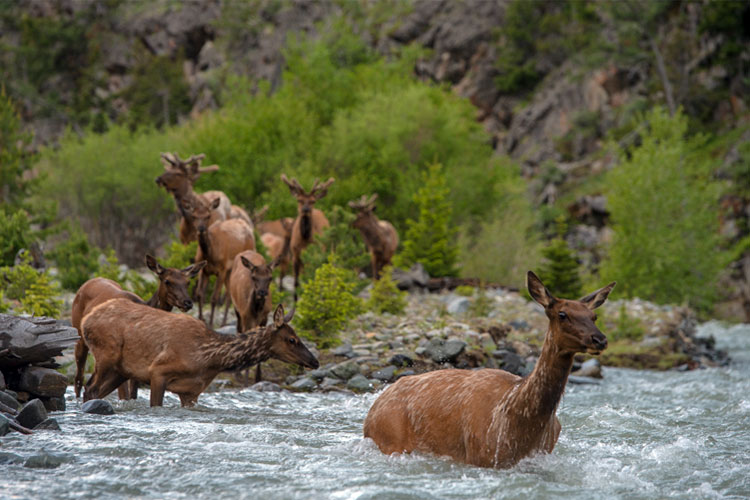Never-before-seen views of elk herds on an incredible journey
UC Berkeley professor Arthur Middleton teamed up with a photographer and an artist to follow — and film — elk herds as they migrate over steep mountain passes and ford treacherous river crossings in Yellowstone

March 7, 2017
A new film produced by a UC Berkeley professor takes viewers on an incredible journey with elk herds on their migration from Wyoming’s ranch lands to Yellowstone’s high-alpine meadows.
The film, Elk River, is directed by filmmaker Jenny Nichols and Joe Riis and produced by Berkeley’s Arthur Middleton, an assistant professor in the Department of Environmental Science, Policy and Management. Middleton teamed up with Riis, who is also a photographer, and artist James Prosek to follow these remarkable ungulates on their journey as they trek over steep mountain passes and ford treacherous river crossings. Along the way, this band of explorers meets backcountry guides, cattle ranchers, and the occasional grizzly bear whose lives are intricately tied to the fate of the elk and other migratory ungulates that live in the Greater Yellowstone Ecosystem [Watch the full film here].
Much of the film’s stunning footage came from a network of camera traps Riis meticulously set and maintained over multiple years, obtaining never-before-seen shots of herds on the move. Additional details on the effort including partnerships behind the film’s production can be found at http://www.greateryellowstonemigrations.com/.
The 28-minute film was selected by National Geographic’s editors for their Short Film Showcase, which spotlights exceptional short videos created by filmmakers from around the web. Films in the showcase affirm National Geographic‘s belief in the power of science, exploration and storytelling to change the world. The film first premiered at Telluride Mountainfilm in May 2016 and is currently traveling in the Banff World Tour but was not publicly released until now.
The trailer for Elk River is above, but you can watch the full film here for free, and read a Q&A with Middleton below.
As a scientist who studies migrations, what motivated you to create a film on the topic?
I had several motivations. Migrations are beautiful and inspiring natural events, and so the film is partly a simple ode to that beauty. But as a scientist, I also know that migration across large landscapes is what makes many herbivores, like the elk we followed, fat and productive and abundant. And in turn, that abundance feeds a lot of other things we care about, like carnivores and scavengers and hunter harvests and tourism. Since migrations are threatened all over the world, I felt there was a special need to convey their importance. And it’s such a visual story, my collaborators and I agreed it just had to be told in film.
Why was the film focused in Yellowstone?
I’ve worked in the Greater Yellowstone Ecosystem for about 10 years studying predator-prey interactions and migrations, and so to a great extent it was focused on Yellowstone because that’s where I work and enjoy spending time. I’ve made a commitment to the place. But I am fortunate, too, that Yellowstone is a laboratory for science and conservation. I thought that if we could tell a compelling story there, we could increase attention to migrations and large landscape conservation ideas more widely.
How did the film get its name?
The name Elk River was our little way to encourage a re-imagining of Yellowstone as a place of ecological wonders, not just the geological ones it was named for. “Elk River” is the translation of an old Native American name for Yellowstone. As the story goes, the first Native Americans encountered by white explorers, the Minnetaree, called the main river in that landscape the River of Yellow Stones. They were referring to the color of the canyon walls. But the Crow tribe called it the Elk River, after the animals they associated it with. We liked that idea, and wanted to highlight the idea of Yellowstone as a place defined by the life that teems within it and spills across its boundaries. What if it was that life, especially the wide-ranging wildlife, that we had used to draw Yellowstone’s boundaries? So that’s why we called the film Elk River.
What can scientists learn by following migrations?
We can learn a lot about how ecosystems work, because when we follow a migration we are basically following the biomass that sustains an ecosystem like Yellowstone. In turn we can also learn a lot about how ecosystems are affected by environmental changes because, by virtue of their wide-ranging movements, migratory populations are exposed to all of the “big” changes – climate, land use, invasive species, and more. So migrations can be bellwethers in a changing world.
What is the most important message that you want people to take home after seeing the film?
There are a few. I want people to come away with an appreciation for what migration means in the context of how ecosystems work, even what ecosystems are. People started talking about a Greater Yellowstone “Ecosystem” decades ago, as a way of talking about the interdependency of Yellowstone and surrounding lands, even lands far beyond its boundaries. This “ecosystem” concept is hugely important to how we manage landscapes like Yellowstone in the future, but it can be quite abstract. I think seeing the migrations like veins and arteries connecting the landscape helps make that concept real.
Related to that, I want viewers to meet the people who also travel along the animals’ trails, so they can see why conserving migrations — conserving all wildlife, really — depends to some degree on all the lands and all the people along the way. We can’t have wildlife connectivity without good human relationships – understanding each other, caring about each other, talking to each other. I hope that message comes through in the film.
